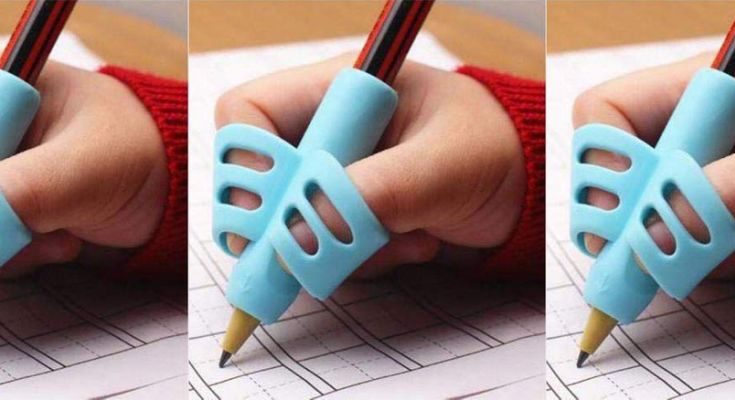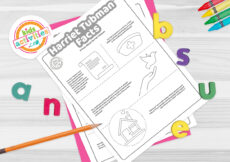Holding a pencil correctly can be extremely difficult for little hands. In fact, in some kids it is physically impossible due to their fine motor development.
Finding ways to solve the incorrect hand position on a pencil early will result in much better handwriting skills and coordination.

Learning the best way to hold a pencil isn’t nearly as easy as it appears.
This problem is near and dear to my heart! Not only am I a Physical Therapist who has worked with kids with this issue and the longterm effects, but I am one of those kids!
I held my pencil incorrectly until 6th grade when I had a teacher shame it out of me in front of the classroom. It was an embarrassment and took some time to re-work my handwriting in a late stage of my hand development.
Let’s talk about the pencil writing tool first and then why it works to correct kids’ pencil grip…
This article includes affiliate links.
If you have a child that struggles with holding their pencil correctly, there is a new writing tool that can change this within a few minutes.
This pencil writing tool looks like this:

Writing Tool Teaches Your Child How to Hold a Pencil Correctly
The pencil grip. Your kids will love that they come in a bunch of different colors like pink, blue, orange and green.

Yes, “Pencil Grip” is the official name and while it may seem unexciting, the tool itself it quite brilliant and helpful! Amazon has named it an Amazon’s Choice for “pencil correction holder for kids” and I would have to agree.
Why Pencil Grip Helps Kids Hold Pencils Correctly
The soft grips help kids learn how to hold a writing utensil correctly.
The silicone grip features two finger pockets for their thumb and index finger, so there’s no room for error.
Look at how the picture below is an example of proper pencil hold position for kids and compare that with the pictures below that discuss the problems that kids have when they hold their pencils wrong:

See how the Pencil Grip positions the thumb and index finger into the holding or pinching position leaving space for just the middle finger to balance. This removes the space kids use to pinch with a third finger and balance with the ring finger.
The Pencil Grip:
- Provides the correct writing position to develop the habit of the proper pencil holding position.
- Designed with ventilation so little fingers don’t overheat!
- Made with silicone so it is a safe and soft product for kids to use.
- Good for all ages – kids aren’t the only ones who need this! Adults who need a little extra stability due to neurological disease or tremor to write can benefit as well. Those who suffer with arthritis can benefit because of the decrease pressure on the hand.
Using Writing Tools in the Classroom for Handwriting
I personally think that this tool should be given to each class in a school and honestly, with Pencil Grip tools being less than $5 each on Amazon, you can afford to get one for every student in your child’s class.
This is going to not only help the students develop better writing skills faster, but allow teachers time to concentrate on things other than correcting pencil grip.

Let’s just agree that this seems a lot easier with a simple tool like this!
Proper Pencil Position for Left-handed Kids
Because of the simple design, the Pencil Grip will work for both right handed kids and left handed kids. I always find it really difficult to assist left handed children with proper positioning because when you try and mirror your own pencil grip position, it feels completely backward!

Now let’s take a deeper look at why kids hold their pencil wrong and additional insight and solutions…
How to Hold a Pencil Correctly
Writing is a challenging task and when your child has to learn cursive, it can become an even bigger one because the letter formation requires more strength and coordination.
The correct pencil holding position looks a little like this:

As you can see in this photograph example, the thumb and the pointer finger (index finger) are responsible for the actual grip on the pencil (in this case a marker) with the pads of the finger tips. The middle finger also makes contact with the pencil, but it is the side of the finger next to the fingernail that is used for balance.
What you see in many children is that they do not hold their pencil correctly. Instead of using three fingers, they end up using four.
The most common improper pencil holding position in kids looks like this:

Reasons Why Kids Hold Their Pencil Wrong
Correct pencil grip is more complicated than you might think because there are several reasons that kids end up holding their pencil with four fingers instead of three fingers. Sometimes it can be just one of these reasons and sometimes several of these reasons collide making it more difficult for them to learn the proper pencil grip:
1. Bad Habit of Holding Pencil Wrong
If a child initially picked up a crayon, pencil or marker and started using an improper grip like a four finger grip, then often they just continue that habit.

2. Decreased Hand Strength
If a child has not developed enough strength in the thumb and index finger to grip the pencil and rely on the middle finger just for balance, then that fourth finger creeps up to take up the slack. You can see from the pictured example that when a child uses four fingers, three of them are doing the actual gripping and the ring finger helps with balance. This allows the child additional muscle power from that extra finger.

3. Decreased Hand Endurance
When we think of endurance, we often think of running long distances, but muscles act like muscles in all parts of the body…even the hand! Even when a child starts a worksheet or writing assignment with the proper pencil hold, as the muscles get tired, they will find their hands making modifications to try to keep on task including that extra finger into the pencil grip to finish the job.
This is one reason why Pediatricians, Occupational Therapists and Physical Therapists (like me) recommend that worksheets and writing assignments be limited as children develop. Let them pace themselves to increase strength and endurance naturally.

4. Decreased Hand Coordination
Think about how amazing the intricate movements of our hands can be and how complicated that is to control. Kids are learning to control their movements and teach their body how to move in the way their brain thinks up. It is all crazy cool!
The fingers and hand are controlled by a system of 35 muscles inside the hand and up the forearm. That is a lot to learn to move together and independently. Many kids don’t have enough practice in to be coordinated with the pencil holding position.

5. Decreased Shoulder Stability
In order for your hand to move freely in a coordinated manner, your arm, head and body have to provide a stable foundation. It is something that you might not have thought about, but try reaching for a pencil in front of you while shrugging your shoulders and moving your head around. Even an adult will have a hard time coordinating that! It is a little like patting your head while rubbing your belly at the same time.
Our body solves this with a really amazing system that attaches our arm to our body/neck through our collar bone and shoulder blade. The muscles in these areas have to have strength, endurance and coordination to allow the fine motor movements of the hand.

How to Help Kids Hold Pencil Properly
- Show them the proper three finger grip with GENTLE reminders – remember, they may not be able to fully control due to developmental level.
- Start them with writing utensils that are bigger in diameter like the big crayons, “fat” pencils and markers. This is one reason why many of the writing instruments created for toddlers and preschoolers are bigger. It takes less effort to write and color with them because the grip is larger and the result is less defined requiring less coordination, etc.
- Be careful about “required” worksheet, coloring page, pencil work time and let kids do this at their own pace to develop pencil skills.
- Use a pencil writing tool…

Check out the Pencil Grip on Amazon.
- Training Pencil Grips – this may work well for kids who are having trouble keeping the middle finger resting as a balancing finger or who have difficulty writing for an age-appropriate amount of time.
- Variety Pack of Pencil Grip types – if your child is struggling to find a writing tool that works for them, this has a variety of different types to choose from.
- Animal Pencil Grips – these have a little different mechanism than the type we talked about in this article, but could be helpful to some kids.
- Traditional triangle pencil grip – this is what I used as a child and I suspect it still works. A bonus is they are some of the cheapest alternatives.
- Ergonomic writing aid – another traditional shape that has worked for years.

Handwriting Activities for Toddlers, Preschool, Kindergarten & Above…
- Use some of the fun techniques for handwriting that are used in name writing practice.
- Check out our list of free handwriting worksheets for kids.
- Make practice fun with these secret writing codes.
- These pre writing worksheets are great for handwriting practice…no matter what developmental level. They can help increase strength & coordination.
- There are a ton of benefits of crafting and beading activities for kids of all ages – one of them is development of fine motor skills that will help their handwriting indirectly.
- Whether you are doing preschool at home or finding fun things to do with your preschooler, we have some play-based solutions to developmental education.
- We have a huge resource for the entire alphabet for kids — writing, tracing, crafts and more for every single letter of the alphabet…yep, all 26!
Did you hold your pencil correctly as a child? What techniques have helped your kids learn how to hold a pencil?



































